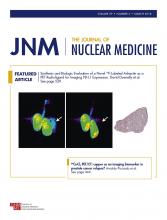See the associated article on page 444.
In this issue of The Journal of Nuclear Medicine, Piccardo et al. (1) propose the use of 64CuCl2 as an alternative PET radiopharmaceutical for investigating recurrent prostate cancer. The authors evaluated 50 prostate cancer patients with biochemical recurrence after definitive therapy (47/50 patients) or after palliative hormonal therapy (3/50 patients). Their specific aims were analysis of biodistribution and dosimetry and comparison of the diagnostic performance of 64CuCl2 with that of 18F-choline PET and multiparametric MRI (mpMRI). Copper concentration is generally increased in several tumors. Human copper transporter 1 is well represented in human cancers, including prostate cancer cells (2). However, the use of 64CuCl2 as a PET tracer has not yet been extensively validated. Previously, the European Medicines Agency approved the use of 64CuCl2 as a precursor for the radiolabeling of carrier molecules specifically developed and authorized for 64Cu labeling (3). 64Cu has been labeled with diacetyl-bis(N4-methylthiosemicarbazone) and proposed as a PET radiopharmaceutical for hypoxia imaging (4), for instance. In addition, 64Cu was labeled with prostate-specific membrane antigen (PSMA)–617 and recently used for investigating prostate cancer patients before surgery (5).
Piccardo et al. (1) report a 64CuCl2 effective dose similar to those of 18F-choline and 68Ga-PSMA-11. 64CuCl2 has a favorable biodistribution for imaging of prostate cancer, with no excretion via the urinary tract. This characteristic represents a potential advantage over 18F-choline for evaluating the pelvis and prostatic bed. As expected, no drug-related pharmacologic effects or physiologic responses were observed immediately after the injection or up to 10 d afterward. From a diagnostic point of view in patients with biochemical recurrence, 64CuCl2 PET/CT showed a higher detection rate than did 18F-choline PET/CT and mpMRI. The detection rate for the assessment of lymph node metastases (64CuCl2, 32%; 18F-choline, 30%; mpMRI, 28%) and bone metastases (64CuCl2, 8%; 18F-choline, 8%; mpMRI, 10%) were approximately equal for both radiotracers. The main advantage for 64CuCl2 was in the evaluation of local recurrence (64CuCl2, 64%; 18F-choline, 30%; mpMRI, 50%).
Nevertheless, on a closer look, among patients with suspected local relapse, mpMRI and 64CuCl2 PET/CT were concordant in 19 patients; 4 patients were 64CuCl2 PET/CT–positive and mpMRI-negative; and 2 patients were mpMRI-positive and 64CuCl2 PET/CT–negative. Although histopathologic confirmation is given for one patient in whom both 64CuCl2 PET/CT and mp-MRI concordantly detected local relapse (Fig. 3), it remains unclear whether discordant cases were true- or false-positive by 64CuCl2 PET/CT. As the authors noted, lack of histopathologic confirmation poses a significant limitation of this study, questioning the true superiority of 64CuCl2 PET/CT over mpMRI. mpMRI is a well-established and widely validated technique for the detection of local recurrence of prostate cancer (6). Of note, 11C-choline is cleared primarily via the hepatobiliary route and might have revealed higher local detection rates (7,8).
Several properties of 64CuCl2 may limit its clinical use in prostate cancer patients: the decay of 64CuCl2 is suboptimal for clinical PET/CT workflows. 64Cu provides 18% β+ decay at a half-life of 12.7 h. Accordingly, acquisition times need to be increased significantly to achieve the counting rates and image quality observed with 68Ga-, 18F-, or 11C-labeled agents. Piccardo et al. performed PET/CT at 6 min per bed position, resulting in a 2–3 times longer total scan time than for 68Ga-, 18F-, or 11C-labeled agents (2–3 min per bed position).
The authors also discuss the possible therapeutic effectiveness of 64Cu delivered by emission of β−-radiation and Auger electrons. Previously, Auger therapy has been applied in patients with neuroendocrine tumors by targeting the somatostatin receptor (9). However, because of low response rates, more effective β−-emitting probes were developed and approved (10). Dosimetry reveals the highest 64CuCl2 uptake in the liver, with an approximately 10 times higher radiation dose than that with 68Ga-PSMA. The liver is generally considered a radiosensitive organ, with increased rates of severe hepatitis and liver failure beyond an 18-Gy total organ dose. Thus, the low efficacy of Auger therapy, and the high liver radiation dose, might limit the therapeutic potential of 64CuCl2.
In conclusion, 64CuCl2 imaging is feasible, with a favorable biodistribution and dosimetry. We congratulate Piccardo et al. for reporting high 64CuCl2 PET/CT detection rates in patients with biochemically recurrent prostate cancer. The results of their study will support a discussion of the use of 64CuCl2 or 64Cu-labeled probes for imaging prostate cancer and other malignancies. Initial data for prostate cancer detection are promising, but further work is needed. The included comparator, that is, choline PET/CT, has been considered suboptimal by most academic PET facilities, which have transitioned to PSMA-directed PET/CT or 18F-fluciclovine PET/CT over the past 2 y (11). We encourage a head-to-head comparison using central image interpretation to investigate the current additional value of 64CuCl2 as compared with currently available receptor-based radiotracers such as 68Ga-PSMA-11 or metabolic radiotracers such as 18F-fluciclovine.
Whether 64CuCl2 will become a real option for prostate cancer diagnosis will clearly depend on its performance compared with PSMA ligands and its regulatory approval and reimbursement.
DISCLOSURE
No potential conflict of interest relevant to this article was reported.
Footnotes
Published online Dec. 14, 2017.
- © 2018 by the Society of Nuclear Medicine and Molecular Imaging.
REFERENCES
- Received for publication September 6, 2017.
- Accepted for publication November 9, 2017.







